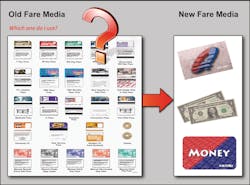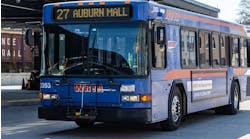ACS wasn’t ACS when its vice president of North American Public Transport, Marc Gordon, joined the company … it wasn’t even in the transit industry.
Gordon started with, “a series of companies” as he calls it in 1990 as a system designer with Fairchild Space & Defense creating systems for satellites. Within three years the company became involved in transit and took the technology it was using for planes and GPS mapping tools and used it for vehicles.
“I’ve been here since day one and it’s really been a lot of fun,” Gordon says.
“I was a system engineer, so I started off designing systems. I had an early stint in business development. Then I went to be a program manager. I managed a number of programs, including Philadelphia, a very large fleet program and then some others and now I am back in business development.”
Taste for Transit
Gordon has been actively involved in the transit industry since he got his first taste of it, including being on standards committees, but what he likes most about transit is the diversity.
“What I like to think, I’ve been [working] on buses since the early ’90s, what I try to convey to my team as a strength is I appreciate the work the maintenance guy on the bus does,” Gordon says, pointing out the operational challenge they have.
“There are a lot, lot of people in transit doing a lot of good work and a lot of hard workers and they have a lot of challenges.
“We try to understand the challenges that they have in all aspects in what we bring to them. So it’s been, it’s really been fun, it’s been enjoyable.”
System Changes
Prior to his work in transit, Gordon spent most of his career working on satellites. But what he found out when he moved to transit was that while the vehicles were different, many of the challenges were the same, which allowed for the technology to cross over.
“I went from satellites to buses and it’s interesting, they are different — the satellite engineers were laughing at times — even though the technology is different, there are technology challenges in these large fleet deployments that are very similar to satellites,” Gordon says.
“Hopefully we don’t have to worry about radiation on a bus and getting burned, but you have to worry about potholes,” he adds with a laugh.
“But really it is a challenging environment that agencies work with and it’s different.
“You can’t factor [riders] in, but I can remember when we first started putting this technology in the bus there was a large concern for vandalism, just knowing the locations of the bus, there was a large concern. And it didn’t pan out,” Gordon says.
“I think it’s like anything else in life.
“Are there a couple problems you are going to have along the way? Probably. But the vast majority there are just trying to use the system.
“And the reality is, and I give the credit to the agencies, there was a large education process done by the agencies, to explain the technology, the purpose for the technology.
“I think overall they’ve been receptive to the systems.”
More than Technology
When I sat down to interview Gordon he took the conversation and ran with it, discussing the latest advancements ACS had made in fare collection. Just from his exuberance I could tell he wasn’t boasting; he was genuinely proud of what they had accomplished. And interestingly enough, he kept coming back to the transit agencies and the people who make all that technology work.
Gordon says adapting new technology to a transit system sometimes can be difficult because, “they like the comfort of their existing systems.
“They’re trying to figure out — and it’s a tough call — ideally you want to take advantage of the new technology, but still hold a little bit of the legacy; and it’s more than the agency, it’s a combination of what their riders are comfortable with.
“So when you’re asking for this combined new technology that could support a legacy, that’s going to be a more expensive investment than were you just going to go to the new technology,” Gordon says.
Gordon says it’s a matter of really understanding your riders and, if you want to make a radical change, having all the necessary planning, marketing and education done in advance.
“We always cite Houston because it’s a really good example,” Gordon says.
“I think they had something in the order of 50 or 60 different types of [fare] cards and this and that, and I think they are down to one.
“But to do that, I think they were very creative. They had a very good education. A very good outreach. They alerted the public. They gave them incentives, monetary incentives.
“And even better it’s all attitude, so when you want to make somewhat of a radical change, it’s more than the technology, it’s the people,” Gordon says.
From A to X
When Gordon talked about being with a series of companies, he meant it. There was Fairchild Space & Defense, Orbital, ACS and now Xerox. The company’s official title is ACS TMS a Xerox Company.
So how do you undergo that amount of change and maintain a quality product? As with agencies integrating new technology when ACS integrated TMS (Transit Management Systems) from Orbital, it’s about the people.
“A merger — it’s firstly cultural between two companies,” Gordon says.
“I think we’re working to that cooperation. I think from our point it went very well. I think there are different styles when you combine two companies, but because there was not a large, maybe degree, of overlap between the fare and fleet management it worked out well.”
Gordon says it’s all about learning the language of integration as systems and companies.
“We’ve had an opportunity now to bring a more U.S. focus on fare collection. We’ve been spending a lot of time working [on] the underlying technology,” Gordon says.
“And each city thinks different, each nation thinks different, but certainly we think working together as integrated systems, as well as integrated companies, has worked out very, very well in my opinion in a very short time.
“Sometimes culturally it just never works out, and it’s not an international [thing], it’s two different cultures of two different companies coming together to work. And I think this worked out very, very well. So I am pleased.”
Keeping it Simple
Gordon stressed to me how important it was for agencies to know their ridership, not only as collected data, but how they would react to implementation of new policies and technologies.
“It’s really, you know when we emphasize it, I think agencies really have to know their ridership, and education I think is No. 1,” Gordon says.
“I think it’s like anything else, if they want to do regionalization they should start that early.
“Do they want to have their new system implement the same fare policy as their old system, which is possible, or do they want to go to a different fare policy on the new system,” Gordon says.
“I hate this, it sounds trite. Our system really has, from the fare rules, almost unlimited possibilities. So when you give too many options to the customer it’s difficult to decide.
“So sometimes it’s better to go to somebody who is an independent consultant to work with them. If I gave them all the options, that would be too much, but we’ve found with too many options it makes the situation difficult.
“And that’s just us, we can do what the agency wants. How many options do they want to give their riders?
“But certainly it seems you want to give them a reasonable number of options that encourages the rider to use mass transit and makes their experience simple. And what that number of options is, is really an agency decision.
“You have to do it in a way … you have to find your real balance between encouraging use and not making it that difficult.”



